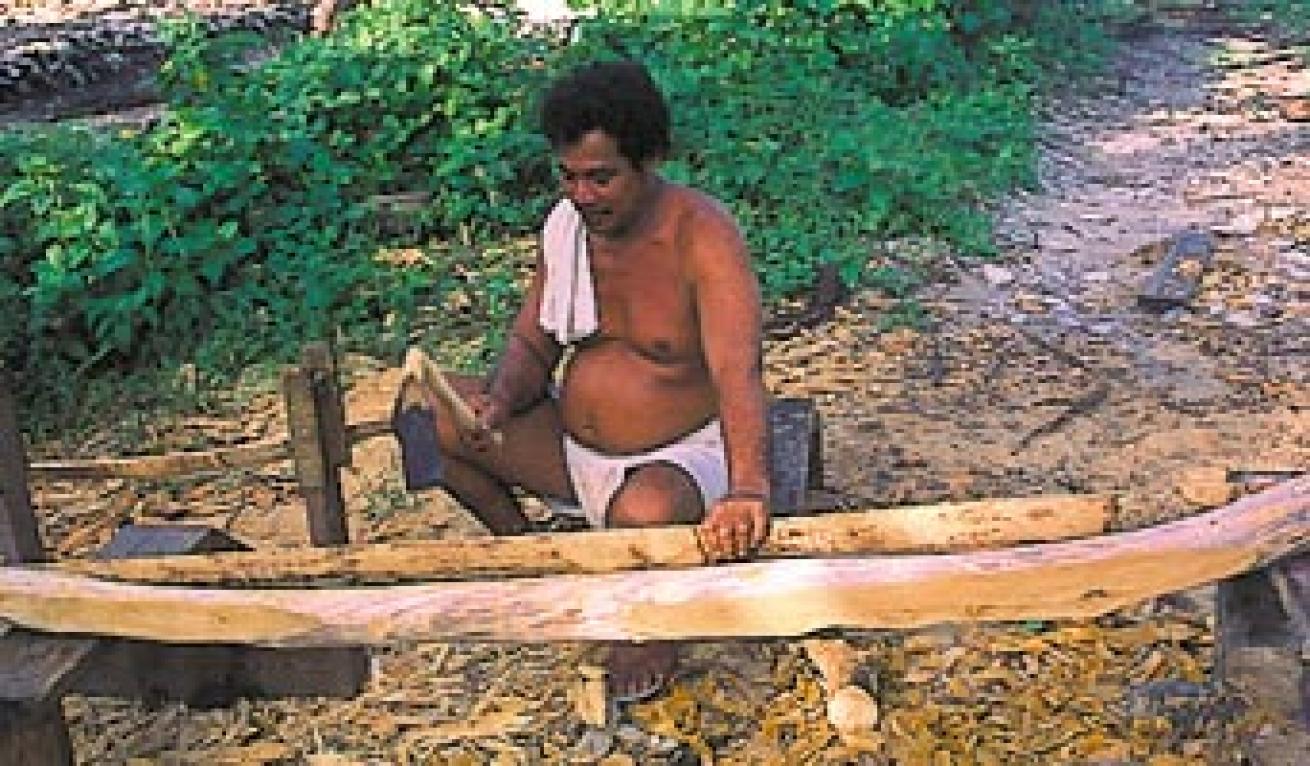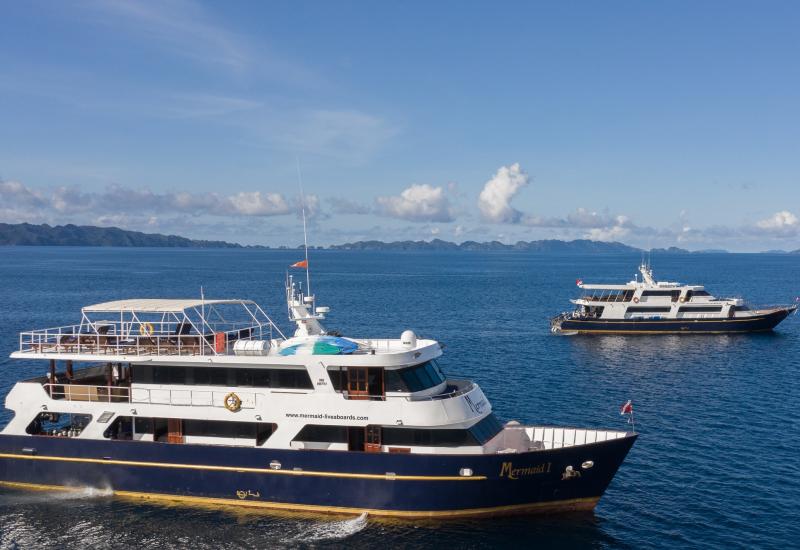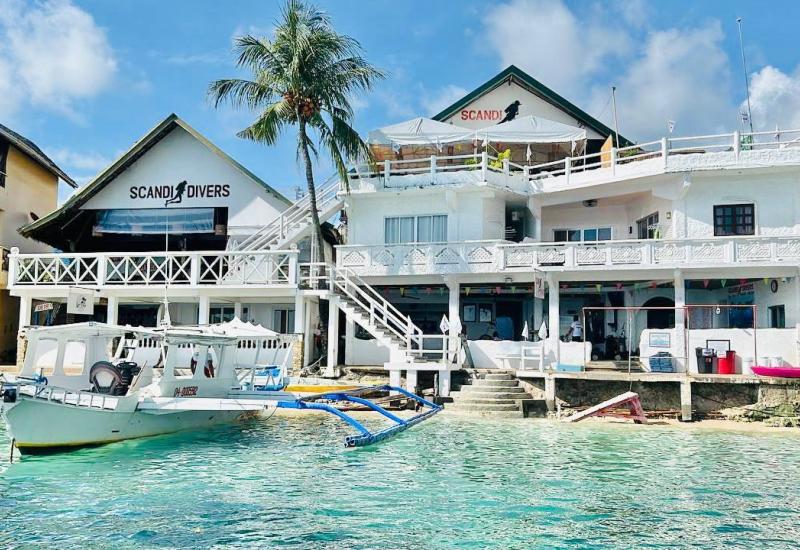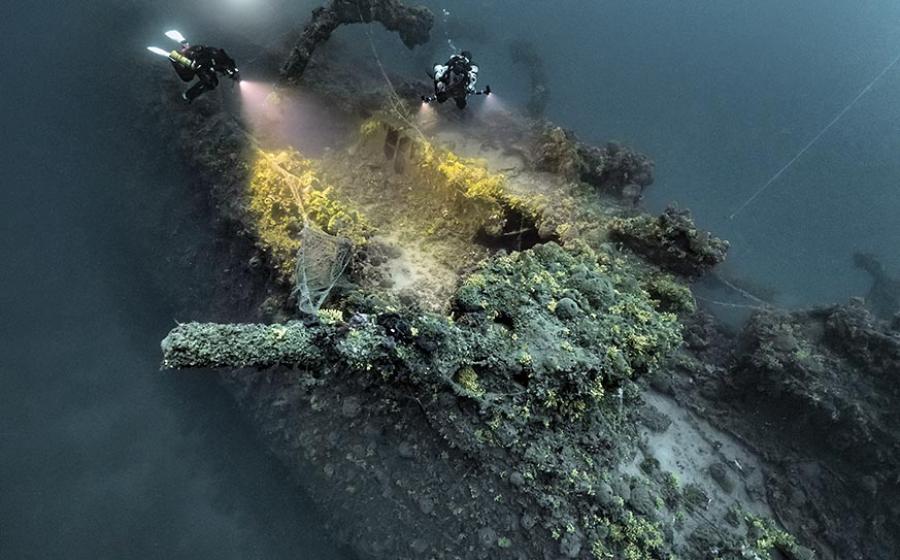Ulithi, Yap
 |
March 2001
By Nick Lucey
Photography by Tim Rock
Tucked away in one of the deepest, darkest corners of military history is Ulithi Atoll, a staging area for the U.S. Navy during World War II. Overshadowed by other Micronesian islands such as Peleliu, Kwajalein and Tarawa, Ulithi was for seven months the world's largest naval facility, a stepping stone in the United States' island-hopping campaign across the Pacific.
The Navy's Secret Weapon
Halfway between Guam and Palau, about 100 miles northeast of Yap's main island lies Ulithi Atoll and its massive lagoon, the world's fourth largest. The atoll is volcanic in origin, with white-sand beaches, beautiful fringing reefs and swaying palm trees. About three dozen small islets--the biggest no more than half a square mile in area--have a combined land area of less than two square miles and ring an 80- to 100-foot-deep lagoon. A population of about 1,000 residents cling to native culture, with men still wearing loin cloths called "thus" and women going topless and wearing skirts called "lavalavas."
The strategic value of Ulithi was apparent to military strategists. Indeed, Admiral Chester Nimitz, commanding officer of Allied forces in the Pacific, went so far as to call Ulithi "the Navy's secret weapon." The huge lagoon was seen as a deep natural anchorage that could easily accommodate hundreds of ships at a time, bigger than any within nearly 1,000 miles. Lying only 1,300 miles from Tokyo, 1,200 miles from Okinawa and 900 miles from Iwo Jima, Ulithi was an ideal staging area for U.S. forces preparing to pounce on Japan.
The very same 3,500-foot runway that divers land on today was originally a Japanese airstrip improved and enlarged by Navy Seabees when U.S. forces occupied the islands in 1944. Native Ulithians were wearing traditional thus and lavalavas, farming coconuts and breadfruit, and subsistence fishing when the Japanese arrived to build a seaplane base in the early '40s. All but three Japanese soldiers departed, and a small invasion force of U.S. soldiers in rubber boats met no resistance when they landed on the islands in September 1944.
The fates of the three Japanese are unknown, but the 400 Ulithians who were living there at the time were moved from the four largest islands to a much smaller one, Fassarai. Seabees then got busy constructing roads, causeways, pontoon piers, administrative buildings, maintenance shops, a radio station, chapel, cemetery, theater, rainwater evaporator, mess hall and recreation facility. The airstrip on Falalop stretched from one end of the island to the other, just big enough to handle the R4Ds and R5Cs that flew in thousands of passengers and a quarter-million pounds of air freight each week from Guam, 360 miles away. Meanwhile, more than 300 tons of seafaring cargo were unloaded each day, arriving from ports in the U.S.
 |
The Missing Wreck
This is an excerpt from a poem written by an anonymous U.S. sailor stationed on Ulithi during the war: "Somewhere in a Western ocean, where the gooneys moan and cry / and the lumbering deep-sea turtles come up on the beach to die / oh, take me back to the place I love so well / for this God-forsaken island is awful close to hell."
And Ulithi was hell for the 50 sailors on the USS Mississinewa (AO-59) who were killed when their ship was struck by a Japanese kaiten, or manned suicide torpedo. The sinking of the ship on Nov. 20, 1944, was one of the most important of the war, the first and only by kaiten. Lieutenant Sekio Nishina, co-inventor of the craft, was the pilot credited for the sinking of the 11,316-ton oiler. Of the five kaitens fired upon the U.S. fleet at Ulithi, four were sunk without hitting their intended targets.
Today, divers still search for the wreckage of the USS Mississinewa; surprising since the vessel is massive, with a length of 553 feet and a beam of 75 feet--more than 50 feet longer than Truk's largest wreck, the Shinkoku Maru. It is theorized that the Mississinewa sits on the bottom of the lagoon in about 140 feet of water. Two informal search parties have failed to find her, so there's still a $500 reward for the person who does. In addition to the oiler, there are also about 20 U.S. Navy landing craft that were scuttled in the lagoon rather than shipped back home.
The Promise of Adventure
But the atoll isn't just wrecks. It's the kind of place where everyday people still come wild-eyed and excited, with the promise of real diving adventure. And some of them leave knowing that they've helped name newly explored reefs. The colorful reefs, sloping walls and steep drop-offs are infested with typical Micronesian reef fish and more sharks than most people see in a lifetime, including huge silvertips.
"I actually got a little scared before I did my first dive," says Mike Musto, owner of Trip-N-Tour, a dive travel specialist who leads trips to the atoll. "The Ulithians--who don't dive--were worried we might be eaten."
But rest assured, you'll probably survive Ulithi's shark encounters. "We were diving off the end of the runway on the island of Falalop," recounts Bill Acker, a former Peace Corps volunteer who lived in Ulithi in the late '70s and now owns the Manta Ray Bay Hotel on Yap. "The wall there is vertical and the deep blue of the water, combined with the clarity, made for excellent visibility. We were at 80 feet drifting along when all of a sudden we were surrounded by at least 30 sharks. Because of the clarity of the water and the sun's rays coming from above, the scene was too pretty to be frightening. What a spectacle. They checked us out for a few moments and vanished just as suddenly as they appeared."
Ulithi is also home to a hawksbill turtle sanctuary at Turtle Island. Visitors come here just before sunset to watch the 300- to 400-pounders come ashore, dig large holes and lay up to 100 eggs each.
As soon as the Philippines were secured, the naval population at Ulithi, then the size of Dallas, moved toward the Japanese mainland, leaving behind nothing more than a small tanker depot. The world's largest, most active naval base quickly morphed back into the quiet, remote tropical atoll it had been before the war. Ulithi, once the U.S. Navy's best-kept secret, is now diving's best-kept secret.
 |
| During World War II, the Ulithi Atoll was transformed into a mighty naval base. Today, Ulithi is once again a peaceful tropical paradise. |
Dive In: Ulithi Atoll
Getting There: Continental Airlines (888-736-9796; www.continental.com) and Continental Micronesia fly to Yap from Guam on Wednesday, Thursday and Saturday. The airline has excellent connections throughout the central and western Pacific. All flights from the continental U.S. funnel through Hawaii, and you'll have a stopover in Guam, which can range from an hour to overnight. You're responsible for accommodations on Guam if necessary. Once you're on Yap, Pacific Missionary Aviation (671-646-6464; www.pmafms.org) operates flights to Ulithi, as well as to Fais and Woleai.
Climate: Temperatures are consistent, averaging around 85F year-round. Humidity ranges from 65 to 100 percent, and the islands get about 120 inches of rainfall a year (mostly in the summer).
What to Bring: Lightweight clothing is ideal. Attire is extremely casual--a former governor once proposed prohibiting the wearing of ties on Yap. Slacks and a collared short-sleeve shirt will be appropriate for even the most formal occasion. Flip-flops are the footwear of choice for most Yapese. For women, cotton dresses, blouses and skirts should suffice. Though Yapese women go topless even around town, baring thighs in public is very offensive to native islanders. Short shorts, bikinis and miniskirts are reserved only for the dive boat and on private beaches.
Water Temperatures: Range from 82F to 86F year-round. Bring at least a skin if you intend to do any wreck diving and to protect yourself from accidental coral cuts. Expect triple-digit visibility outside the lagoon and on walls. You'll find the water inside the lagoon not as clear.
Electricity: 110 volts, 60 cycles; the same as in the United States.
Entry Requirements: Despite what some travel guides say, it's a good idea to take a passport.
Money Matters: Micronesia has no unique currency and the U.S. dollar is accepted throughout Yap. There are no banks on Ulithi; however, there are two banks on Yap proper--the Bank of the FSM and the Bank of Hawaii. Credit cards are accepted by most hotels, and traveler's checks are recommended for shopping and at restaurants.

March 2001
By Nick Lucey
Photography by Tim Rock
Tucked away in one of the deepest, darkest corners of military history is Ulithi Atoll, a staging area for the U.S. Navy during World War II. Overshadowed by other Micronesian islands such as Peleliu, Kwajalein and Tarawa, Ulithi was for seven months the world's largest naval facility, a stepping stone in the United States' island-hopping campaign across the Pacific.
The Navy's Secret Weapon
Halfway between Guam and Palau, about 100 miles northeast of Yap's main island lies Ulithi Atoll and its massive lagoon, the world's fourth largest. The atoll is volcanic in origin, with white-sand beaches, beautiful fringing reefs and swaying palm trees. About three dozen small islets--the biggest no more than half a square mile in area--have a combined land area of less than two square miles and ring an 80- to 100-foot-deep lagoon. A population of about 1,000 residents cling to native culture, with men still wearing loin cloths called "thus" and women going topless and wearing skirts called "lavalavas."
The strategic value of Ulithi was apparent to military strategists. Indeed, Admiral Chester Nimitz, commanding officer of Allied forces in the Pacific, went so far as to call Ulithi "the Navy's secret weapon." The huge lagoon was seen as a deep natural anchorage that could easily accommodate hundreds of ships at a time, bigger than any within nearly 1,000 miles. Lying only 1,300 miles from Tokyo, 1,200 miles from Okinawa and 900 miles from Iwo Jima, Ulithi was an ideal staging area for U.S. forces preparing to pounce on Japan.
The very same 3,500-foot runway that divers land on today was originally a Japanese airstrip improved and enlarged by Navy Seabees when U.S. forces occupied the islands in 1944. Native Ulithians were wearing traditional thus and lavalavas, farming coconuts and breadfruit, and subsistence fishing when the Japanese arrived to build a seaplane base in the early '40s. All but three Japanese soldiers departed, and a small invasion force of U.S. soldiers in rubber boats met no resistance when they landed on the islands in September 1944.
The fates of the three Japanese are unknown, but the 400 Ulithians who were living there at the time were moved from the four largest islands to a much smaller one, Fassarai. Seabees then got busy constructing roads, causeways, pontoon piers, administrative buildings, maintenance shops, a radio station, chapel, cemetery, theater, rainwater evaporator, mess hall and recreation facility. The airstrip on Falalop stretched from one end of the island to the other, just big enough to handle the R4Ds and R5Cs that flew in thousands of passengers and a quarter-million pounds of air freight each week from Guam, 360 miles away. Meanwhile, more than 300 tons of seafaring cargo were unloaded each day, arriving from ports in the U.S.

The Missing Wreck
This is an excerpt from a poem written by an anonymous U.S. sailor stationed on Ulithi during the war: "Somewhere in a Western ocean, where the gooneys moan and cry / and the lumbering deep-sea turtles come up on the beach to die / oh, take me back to the place I love so well / for this God-forsaken island is awful close to hell."
And Ulithi was hell for the 50 sailors on the USS Mississinewa (AO-59) who were killed when their ship was struck by a Japanese kaiten, or manned suicide torpedo. The sinking of the ship on Nov. 20, 1944, was one of the most important of the war, the first and only by kaiten. Lieutenant Sekio Nishina, co-inventor of the craft, was the pilot credited for the sinking of the 11,316-ton oiler. Of the five kaitens fired upon the U.S. fleet at Ulithi, four were sunk without hitting their intended targets.
Today, divers still search for the wreckage of the USS Mississinewa; surprising since the vessel is massive, with a length of 553 feet and a beam of 75 feet--more than 50 feet longer than Truk's largest wreck, the Shinkoku Maru. It is theorized that the Mississinewa sits on the bottom of the lagoon in about 140 feet of water. Two informal search parties have failed to find her, so there's still a $500 reward for the person who does. In addition to the oiler, there are also about 20 U.S. Navy landing craft that were scuttled in the lagoon rather than shipped back home.
The Promise of Adventure
But the atoll isn't just wrecks. It's the kind of place where everyday people still come wild-eyed and excited, with the promise of real diving adventure. And some of them leave knowing that they've helped name newly explored reefs. The colorful reefs, sloping walls and steep drop-offs are infested with typical Micronesian reef fish and more sharks than most people see in a lifetime, including huge silvertips.
"I actually got a little scared before I did my first dive," says Mike Musto, owner of Trip-N-Tour, a dive travel specialist who leads trips to the atoll. "The Ulithians--who don't dive--were worried we might be eaten."
But rest assured, you'll probably survive Ulithi's shark encounters. "We were diving off the end of the runway on the island of Falalop," recounts Bill Acker, a former Peace Corps volunteer who lived in Ulithi in the late '70s and now owns the Manta Ray Bay Hotel on Yap. "The wall there is vertical and the deep blue of the water, combined with the clarity, made for excellent visibility. We were at 80 feet drifting along when all of a sudden we were surrounded by at least 30 sharks. Because of the clarity of the water and the sun's rays coming from above, the scene was too pretty to be frightening. What a spectacle. They checked us out for a few moments and vanished just as suddenly as they appeared."
Ulithi is also home to a hawksbill turtle sanctuary at Turtle Island. Visitors come here just before sunset to watch the 300- to 400-pounders come ashore, dig large holes and lay up to 100 eggs each.
As soon as the Philippines were secured, the naval population at Ulithi, then the size of Dallas, moved toward the Japanese mainland, leaving behind nothing more than a small tanker depot. The world's largest, most active naval base quickly morphed back into the quiet, remote tropical atoll it had been before the war. Ulithi, once the U.S. Navy's best-kept secret, is now diving's best-kept secret.

During World War II, the Ulithi Atoll was transformed into a mighty naval base. Today, Ulithi is once again a peaceful tropical paradise.
Dive In: Ulithi Atoll
Getting There: Continental Airlines (888-736-9796; www.continental.com) and Continental Micronesia fly to Yap from Guam on Wednesday, Thursday and Saturday. The airline has excellent connections throughout the central and western Pacific. All flights from the continental U.S. funnel through Hawaii, and you'll have a stopover in Guam, which can range from an hour to overnight. You're responsible for accommodations on Guam if necessary. Once you're on Yap, Pacific Missionary Aviation (671-646-6464; www.pmafms.org) operates flights to Ulithi, as well as to Fais and Woleai.
Climate: Temperatures are consistent, averaging around 85F year-round. Humidity ranges from 65 to 100 percent, and the islands get about 120 inches of rainfall a year (mostly in the summer).
What to Bring: Lightweight clothing is ideal. Attire is extremely casual--a former governor once proposed prohibiting the wearing of ties on Yap. Slacks and a collared short-sleeve shirt will be appropriate for even the most formal occasion. Flip-flops are the footwear of choice for most Yapese. For women, cotton dresses, blouses and skirts should suffice. Though Yapese women go topless even around town, baring thighs in public is very offensive to native islanders. Short shorts, bikinis and miniskirts are reserved only for the dive boat and on private beaches.
Water Temperatures: Range from 82F to 86F year-round. Bring at least a skin if you intend to do any wreck diving and to protect yourself from accidental coral cuts. Expect triple-digit visibility outside the lagoon and on walls. You'll find the water inside the lagoon not as clear.
Electricity: 110 volts, 60 cycles; the same as in the United States.
Entry Requirements: Despite what some travel guides say, it's a good idea to take a passport.
Money Matters: Micronesia has no unique currency and the U.S. dollar is accepted throughout Yap. There are no banks on Ulithi; however, there are two banks on Yap proper--the Bank of the FSM and the Bank of Hawaii. Credit cards are accepted by most hotels, and traveler's checks are recommended for shopping and at restaurants.










